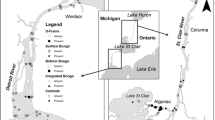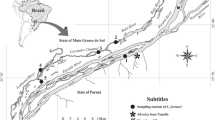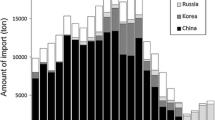Abstract
Human-mediated transport and aquaculture have promoted the establishment of non-indigenous species in many estuaries around the world over the last century. This phenomenon has been demonstrated as a major cause of biodiversity alterations, which has prompted scientists to provide explanations for the success or failure of biological invasions. Crepidula fornicata is a gastropod native from the East coast of North America which has successfully invaded many European bays and estuaries since the 19th century, with some noticeable exceptions. Its spread over Europe has been explained by a combination of human-mediated transport and natural dispersal through its long-lived planktonic larva. We here investigated whether larval supply may explain the failure in the proliferation of this species within a particular bay, the Bay of Morlaix (France). Patterns of larval distribution and larval size structure were analysed over ten sites sampled three times (20 July, 4 August and 21 August 2006), regarding characteristics of the adult population and environmental features. Our results evidenced a strong spatial structure in both larval abundance and size at the bay scale, even if larval abundances were low. In this scheme, the location of spawning adults played a critical role, with high numbers of early larvae above the main spawning location. The larval size structure further showed that settlement-stage larvae were rare, which suggested that released larvae might have been exported out of the bay. The use of an analytical model aimed to study the effect of tidal currents on the potential for larval exportation confirmed that larval retention within the bay might be low. The limitation in larval supply resulting from the interactions between spawning location and local hydrodynamics may thus impede the proliferation of this species which is well established for more than 50 years. This study provided an example of factors which may explain the failure of the transition between two major steps of biological invasions, i.e. sustainable establishment and proliferation.





Similar content being viewed by others
References
Barnay AS, Ellien C, Gentil F, Thiébaut E (2003) A model study on variations in larval supply: are populations of the polychaete Owenia fusiformis in the English Channel open or closed? Helgol Mar Res 56:229–237
Barnes RSK, Coughlan J, Holmes NJ (1973) A preliminary survey of the macroscopic bottom fauna of the Solent, with particular reference to Crepidula fornicata and Ostrea edulis. Proc Malacol Soc Lond 40:253–275
Bhaud M (2000) Two contradictory elements determine invertebrates recruitment: dispersion of larvae and spatial restrictions on adults. Oceanol Acta 23:409–422
Black KP, Gay SL, Andrews JC (1990) Residence times of neutrally-buoyant matter such as larvae, sewage or nutrients on coral reefs. Coral Reefs 9:105–114
Blanchard M (1995) Origine et état de la population de Crepidula fornicata (Gastropoda Prosobranchia) sur le littoral français. Haliotis 24:75–86
Blanchard M (1997) Spread of the slipper limpet Crepidula fornicata (L.1758) in Europe: current state and consequences. Sci Mar 61:109–118
Blanchard M (2009) Recent expansion of the slipper limpet population (Crepidula fornicata) in the Bay of Mont-Saint-Michel (Western Channel, France). Aquat Living Resour 22:11–19
Blanchet FG, Legendre P, Borcard D (2008) Forward selection of explanatory variables. Ecology 89:2623–2632
Byers JE, Pringle JM (2006) Going against the flow: retention, range limits and invasions in advective environments. Mar Ecol Prog Ser 313:27–41
Cabioch L (1968) Contribution à la connaissance des peuplements benthiques de la Manche occidentale. Cah Biol Mar 9:493–720
Cabioch L, Douvillé JL (1979) La circulation des eaux dans la baie de Morlaix et ses abords: premières données obtenues par suivis de flotteurs dérivants. Trav St Biol Roscoff 26:11–20
Cameron B, Metaxas A (2005) Invasive green crab, Carcinus maenas, on the Atlantic coast and in the Bras d’Or Lakes of Nova Scotia, Canada: larval supply and recruitment. J Mar Biol Ass U K 85:847–855
Carlton JT, Geller JB (1993) Ecological roulette: the global transport of nonindigenous marine organisms. Science 261:78–82
Chipperfield PNJ (1951) The breeding of Crepidula fornicata (L.) in the river Blackwater, Essex. J Mar Biol Ass U K 30:49–71
Coe WR (1936) Sexual phases in Crepidula. J Exp Zool 72:455–477
Cohen AN, Carlton JT (1998) Accelerating invasion rate in a highly invaded estuary. Science 279:555–558
Conq C, Dauvin JC, Lorgeré JC (1998) Température et salinité de l’eau de mer au large de Roscoff de 1991 à 1997. Cah Biol Mar 39:207–212
Coum A (1979) La population de crépidules Crepidula fornicata (L. 1758) en rade de Brest: écologie et dynamique. Thèse de doctorat, Université de Bretagne Occidentale, Brest, France
Dame RF, Allen DM (1996) Between estuaries and the sea. J Exp Mar Biol Ecol 200:169–185
de Montaudouin X, Sauriau PG (1999) The proliferating Gastropoda Crepidula fornicata may stimulate macrozoobenthic diversity. J Mar Biol Ass U K 79:1069–1077
de Montaudouin X, Labarraque D, Giraud K, Bachelet G (2001) Why does the introduced gastropod Crepidula fornicata fail to invade Arcachon Bay (France)? J Mar Biol Ass U K 81:97–104
deRivera CE, Hitchcock NG, Teck SJ, Hines AH, Ruiz GM (2007) Larval development rate predicts range expansion of an introduced crab. Mar Biol 150:1275–1288
Deslous-Paoli JM (1985) Crepidula fornicata L. (gastéropode) dans le bassin de Marennes-Oléron: structure, dynamique et production d’une population. Oceanol Acta 8:453–460
Drake JM, Lodge DM (2006) Allee effect, propagule pressure and the probability of the establishment: risk analysis for biological invasions. Biol Invasions 8:365–375
Dubois S, Comtet T, Retière C, Thiébaut E (2007) Distribution and retention of Sabellaria alveolata larvae (Polychaeta: Sabellariidae) in the Bay of Mont-Saint-Michel, France. Mar Ecol Prog Ser 346:243–254
Dunstan PK, Bax NJ (2007) How far can marine species go? Influence of population biology and larval movement on future range limits. Mar Ecol Prog Ser 344:15–28
Dupont L (2004) Invasion des côtes françaises par le mollusque exotique Crepidula fornicata: contribution de la dispersion larvaire et du système de reproduction au succès de la colonisation. Thèse de doctorat, Université Pierre et Marie Curie-Paris 6, Paris
Dupont L, Jollivet D, Viard F (2003) High genetic diversity and ephemeral drift effects in a successful introduced mollusc (Crepidula fornicata: Gastropoda). Mar Ecol Prog Ser 253:183–195
Dupont L, Ellien C, Viard F (2007) Limits to gene flow in the slipper limpet Crepidula fornicata as revealed by microsatellite data and a larval dispersal model. Mar Ecol Prog Ser 349:125–138
Edwards KP, Hare JA, Werner FE, Seim H (2007) Using 2-dimensional dispersal kernels to identify the dominant influences on larval dispersal on continental shelves. Mar Ecol Prog Ser 352:77–87
Ehrhold A, Blanchard M, Auffret JP, Garlan T (1998) Conséquences de la prolifération de la crépidule (Crepidula fornicata) sur l’évolution sédimentaire de la baie du Mont-Saint-Michel (Manche, France). C R Acad Sci Paris Sci Terre Planet 327:583–588
Frontier S, Pichod-Viale D (1991) Ecosystèmes: structure, fonctionnement, évolution. Masson, Paris
Gaines S, Roughgarden J (1985) Larval settlement rate: a leading determinant of structure in an ecological community of the marine intertidal zone. Proc Natl Acad Sci USA 82:3707–3711
Geyer WR, Signell RP (1992) A reassessment of the role of tidal dispersion in estuaries and bays. Estuaries 15:97–108
Gros P, Cochard JC (1978) Biologie de Nyctiphanes couchii (Crustacea, euphasiacea) dans le secteur Nord du Golfe de Gascogne. Ann Inst Océanogr 54:25–46
Jollivet D, Empis A, Baker MC, Hourdez S, Comtet T, Jouin-Toulmond C, Desbruyères D, Tyler PA (2000) Reproductive biology, sexual dimorphism, and population structure of the deep sea hydrothermal vent scale-worm, Branchipolynoe seepensis (Polychaeta: Polynoidae). J Mar Biol Ass U K 80:55–68
Kinlan BP, Gaines SD, Lester SE (2005) Propagule dispersal and the scales of marine community process. Diversity Distrib 11:139–148
Kutner MH, Nachtsheim CJ, Neter J, Li W (2004) Applied linear statistical models, 5th edn. McGraw-Hill Irwin, New York
Le Cam S (2009) Modalités de la reproduction chez l’espèce hermaphrodite protandre Crepidula fornicata: paternité et changement de sexe. Thèse de doctorat, Université Pierre et Marie Curie-Paris 6, Paris
Legendre P, Gallagher ED (2001) Ecologically meaningful transformations for ordination of species data. Oecologia 129:271–280
Legendre P, Legendre L (1998) Numerical ecology, 2nd edn. Elsevier, Amsterdam
Leppäkoski E, Olenin S (2000) Non-native species and rates of spread: lessons from the brackish Baltic Sea. Biol Invasions 2:151–163
Loomis SH, Van Nieuwenhuyze W (1985) Sediment correlates to density of Crepidula fornicata Linnaeus in the Pataguanset River, Connecticut. Veliger 27:266–272
Lorenzen CJ (1966) A method for the continuous measurement of in vivo chlorophyll a concentration. Deep-Sea Res 13:223–227
Martin S, Thouzeau G, Chauvaud L, Jean F, Guérin L, Clavier J (2006) Respiration, calcification, and excretion of the invasive slipper limpet, Crepidula fornicata L.: implications for carbon, carbonate, and nitrogen fluxes in affected areas. Limnol Oceanogr 51:1996–2007
McGee BL, Targett NM (1989) Larval habitat selection in Crepidula (L.) and its effect on adult distribution patterns. J Exp Mar Biol Ecol 131:195–214
Naylor RL, Williams SL, Strong DR (2001) Aquaculture-a gateway for exotic species. Science 294:1655–1656
Nehring S (2006) Four arguments why so many alien species settle into estuaries, with special reference to the German river Elbe. Helgol Mar Res 60:127–134
Paavola M, Olenin S, Leppäkoski E (2005) Are invasive species most successful in habitats of low native species richness across European brackish water seas? Est Coast Shelf Sci 64:738–750
Pechenik JA (1999) On the advantages and disadvantages of larval stages in benthic marine invertebrate life cycles. Mar Ecol Prog Ser 177:269–297
Pechenik JA, Heyman WD (1987) Using KCl to determine size at competence for larvae of the marine gastropod Crepidula fornicata (L.). J Exp Mar Biol Ecol 112:27–38
Pechenik JA, Lima GM (1984) Relationship between growth, differentiation, and length of larval life for individually reared larvae of the marine gastropod, Crepidula fornicata. Biol Bull 166:537–549
Pedersen TM, Hansen JLS, Josefson AB, Hansen BW (2008) Mortality through ontogeny of soft-bottom marine invertebrates with planktonic larvae. J Mar Syst 73:185–207
Plus M, Maurer D, Stanisière JY, Dumas F (2006) Caractérisation des composantes hydrodynamiques d’une lagune mésotidale, le Bassin d’Arcachon. Report RST/LER/AR/06.007. IFREMER, Arcachon, France
Quiniou F, Blanchard M (1987) État de la prolifération de la crépidule (Crepidula fornicata L.) dans le secteur de Granville (golfe normano-breton). Haliotis 16:513–526
Reise K, Olenin S, Thieltges DW (2006) Are aliens threatening European aquatic coastal ecosystems? Helgol Mar Res 60:77–83
Richard J, Huet M, Thouzeau G, Paulet YM (2006) Reproduction of the invasive slipper limpet, Crepidula fornicata, in the Bay of Brest, France. Mar Biol 149:789–801
Rigal F (2009) Étude de la dynamique spatio-temporelle du nuage larvaire du gastéropode introduit Crepidula fornicata dans une baie mégatidale, la baie de Morlaix. Thèse de doctorat, Université Pierre et Marie Curie-Paris 6, Paris
Roughgarden J, Gaines SD, Possingham H (1988) Recruitment dynamics in complex life cycles. Science 241:1460–1466
Rumrill SS (1990) Natural mortality of marine invertebrate larvae. Ophelia 32:163–198
Salomon JC, Breton M (1991) Courants résiduels de marée dans la Manche. Oceanol Acta 11:47–53
Sauriau PG, Pichocki-Seyfried C, Walker P, de Montaudouin X, Palud C, Héral M (1998) Crepidula fornicata L. (mollusque, gastéropode) en baie de Marennes-Oléron: cartographie des fonds par sonar à balayage latéral et estimation du stock. Oceanol Acta 21:353–362
Schneider DW, Stoeckel JA, Rehmann CR, Douglas Blodgett K, Sparks RE, Padilla DK (2003) A developmental bottleneck in dispersing larvae: implications for spatial population dynamics. Ecol Lett 6:352–360
Simberloff D (2009) The role of propagule pressure in biological invasions. Ann Rev Ecol Evol Syst 40:81–102
Simberloff D, Gibbons L (2004) Now you see them, now you don’t!—population crashes of established introduced species. Biol Invasions 6:161–172
Thiébaut E, Dauvin J-C, Lagadeuc Y (1992) Transport of Owenia fusiformis larvae (Annelida: Polychaeta) in the Bay of Seine. I. Vertical distribution in relation to water column stratification and ontogenic vertical migration. Mar Ecol Prog Ser 80:29–39
Thieltges DW, Strasser M, van Beusekom JEE, Reise K (2004) Too cold to prosper—winter mortality prevents population increase of the introduced American slipper limpet Crepidula fornicata in northern Europe. J Exp Mar Biol Ecol 311:375–391
Todd CD (1998) Larval supply and recruitment of benthic invertebrates: do larvae always disperse as much as we believe? Hydrobiologia 375(376):1–21
UNESCO (1968) Zooplankton sampling. Monographs on oceanographic methodology. UNESCO, Paris, p 174
Viard F, Ellien C, Dupont L (2006) Dispersal ability and invasion success of Crepidula fornicata in a single gulf: insights from genetic markers and larval-dispersal model. Helgol Mar Res 60:144–152
Voisin M, Engel CR, Viard F (2005) Differential shuffling of native genetic diversity across introduced regions in a brown alga: aquaculture vs. maritime traffic effects. Proc Natl Acad Sci USA 102:5432–5437
Acknowledgments
We are grateful to our colleagues from Service Mer et Observation at the Station Biologique de Roscoff for their help in field sampling. We particularly acknowledge Laurent Lévêque who provided us with parameters calculated for the analytical model. We are grateful to Pr. Pierre Legendre for his help in statistical analyses. We thank two anonymous reviewers for their fruitful comments on an earlier version of this manuscript. FR and SDA acknowledge a PhD fellowship from the Ministère de la Recherche et de l’Enseignement Supérieur. This work was supported by the Agence Nationale de la Recherche (MIRAGE contract no NT05-3_42438).
Author information
Authors and Affiliations
Corresponding author
Electronic supplementary material
Below is the link to the electronic supplementary material.
Appendix
Appendix
The descriptions and the values of the parameters used in the analytical model are given in Table 2. Figure 6 gives the schematic representation of the study bay used in the analytical model. Two regions are considered. The region B is delimited in the north by a section of surface s 1(t). The adult population is located within the region B at a distance x of the section s 1(t). The region E is defined as the area outside the bay where the larvae released from the adult population can be exported by the tide: its width L is equal to x T − x, where x T is the maximal tidal excursion. The surface s 1(t) of the section separating the regions B and E varies with the tidal cycle and is given by:
with W the length of the region E, h the mean depth of the bay, and ε(t) the free surface elevation.
Schematic view of the bay used to construct the analytical model. Meaning of the letters are presented in Table 2. The two white dots indicate the innermost and outermost spawning locations which were used in the model, with a distance within the bay of 8 and 1 km, respectively
The section of surface s 2(t) is the other section of the region E. By this section, larvae are exported outside E by the offshore residual current U. s 2(t) also varies with the tidal cycle following:
The volume V B (t) of the region B is calculated from the surface of the bay S, the mean depth of the bay h, and the free surface elevation ε(t) following the equation:
and the volume V E (t) of the region E is calculated from:
The volume V 1 (t) exchanged between the regions B and E according to the tidal current u(t) through the section of surface s 1(t) and during a time step Δt is defined by:
and the volume V 2 (t) removed from region E by the residual current U through the section of surface s 2(t) during a time step Δt is defined by:
Using those equations, the final equations of the analytical model are:
-
During ebb:
$$ N_{B} (t + \Updelta t) = N_{B} (t) \times \left( {1 - {\frac{u(t) \times W \times \Updelta t}{S}}} \right) $$(11)$$ N_{E} (t + \Updelta t) = N_{E} (t) \times \left( {1 - {\frac{U \times \Updelta t}{W}}} \right) \,+\, {\frac{u(t) \times W \times \Updelta t}{S}} \times N_{B} (t) $$(12) -
During flow:
$$ N_{B} (t + \Updelta t) = N_{B} (t) + {\frac{u(t) \times \Updelta t}{{(x_{T} - x)}}} \times N_{E} (t) $$(13)$$ N_{E} (t + \Updelta t) = N_{E} (t) \times \left( {1 - {\frac{U \times \Updelta t}{W}} - {\frac{u(t) \times \Updelta t}{{(x_{T} - x)}}}} \right) $$(14)
Rights and permissions
About this article
Cite this article
Rigal, F., Viard, F., Ayata, SD. et al. Does larval supply explain the low proliferation of the invasive gastropod Crepidula fornicata in a tidal estuary?. Biol Invasions 12, 3171–3186 (2010). https://doi.org/10.1007/s10530-010-9708-9
Received:
Accepted:
Published:
Issue Date:
DOI: https://doi.org/10.1007/s10530-010-9708-9





